Navicular Stress Fracture
Updated:
(Also known as Stress Fracture of the Navicular)
What is a navicular stress fracture?
A navicular stress fracture is a condition characterized by an incomplete crack in the navicular bone. The navicular is the anatomical name given to one of the bones in the mid-foot. It is located at the top of the arch of the foot (figures 1 & 2).

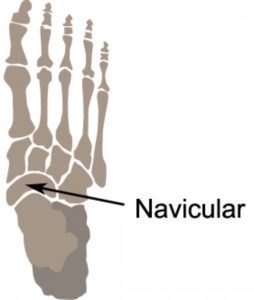
A muscle (known as the tibialis posterior) attaches to the navicular bone. When this muscle contracts, a pulling force is exerted on the bone. Furthermore, weight bearing activity places compressive force through the navicular. When these forces are excessive or too repetitive and beyond what the bone can withstand, bony damage can gradually occur. This initially results in a bony stress reaction, however, with continued damage may progress to a navicular stress fracture.
Cause of a navicular stress fracture
A stress fracture of the navicular typically occurs over time with excessive weight bearing activity such as running, sprinting, jumping or dancing. They often occur following a recent increase in activity or change in training conditions (such as surface, footwear or technique changes etc).
Signs and symptoms of a navicular stress fracture
Patients with this condition typically experience a poorly localized pain in the inner arch of the foot or ankle that increases with impact activity (such as running, jumping, sprinting and hopping) and decreases with rest. As symptoms worsen, the patient may limp during weight bearing activity and may have to stop activity due to pain.Occasionally, pain may radiate to the outer aspect of the foot, the second and third toes or the inner aspect of the heel bone. In severe cases, walking or standing may be enough to aggravate symptoms. Other symptoms may include night ache or pain on firmly touching the navicular bone.
Diagnosis of a navicular stress fracture
A thorough subjective and objective examination from a physiotherapist may be sufficient to diagnose a navicular stress fracture. Further investigations such as an X-ray, MRI, CT scan or bone scan are usually required to confirm diagnosis and determine the severity of injury.
Prognosis of a navicular stress fracture
With appropriate physiotherapy management, most patients with a stress fracture of the navicular can make a full recovery (return to sport or full activities) in a period of 3 – 9 months. In more severe cases, recovery may take 1 year, or longer, depending on the intervention required and a range of other factors. In rare cases, some patients may experience ongoing symptoms or complications which may require further management.
Treatment for a navicular stress fracture

Members Only ContentBecome a PhysioAdvisor Member to gain full access to this exclusive content. For more details see Become a Member. Already a member? Login Now
Contributing factors to the development of a navicular stress fracture

Members Only ContentBecome a PhysioAdvisor Member to gain full access to this exclusive content. For more details see Become a Member. Already a member? Login Now
Physiotherapy for a navicular stress fracture

Members Only ContentBecome a PhysioAdvisor Member to gain full access to this exclusive content. For more details see Become a Member. Already a member? Login Now
Other intervention for a navicular stress fracture

Members Only ContentBecome a PhysioAdvisor Member to gain full access to this exclusive content. For more details see Become a Member. Already a member? Login Now
Exercises for a navicular stress fracture
The following exercises are commonly prescribed to patients with a navicular stress fracture following the initial period of immobilisation. You should discuss the suitability of these exercises with your physiotherapist prior to beginning them. Generally, they should be performed 2 – 3 times daily once the physiotherapist has indicated it is safe to do so and only provided they do not cause or increase symptoms.
Your physiotherapist can advise when it is appropriate to begin the initial exercises and eventually progress to the intermediate and advanced exercises. As a general rule, addition of exercises or progression to more advanced exercises should take place provided there is no increase in symptoms
Initial Exercises
Foot & Ankle Up & Down
Move your foot and ankle up and down as far as you can go without pain and provided you feel no more than a mild to moderate stretch (figure 3). Repeat 10 – 20 times provided there is no increase in symptoms.
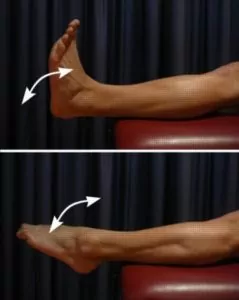
Foot & Ankle In & Out
Move your foot and ankle in and out as far as you can go without pain and provided you feel no more than a mild to moderate stretch (figure 4). Repeat 10 – 20 times provided there is no increase in symptoms.
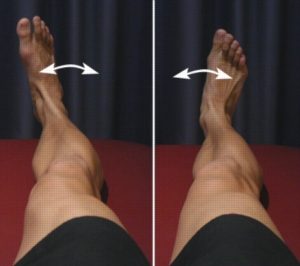
Foot and Ankle Circles
Move your foot and ankle in a circle as large as you can go without pain and provided you feel no more than a mild to moderate stretch (figure 5). Repeat 10 – 20 times in both clockwise and anticlockwise directions provided there is no increase in symptoms.
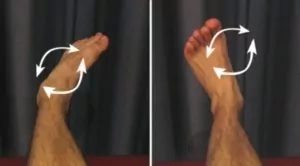
Intermediate Exercises

Members Only ContentBecome a PhysioAdvisor Member to gain full access to this exclusive content. For more details see Become a Member. Already a member? Login Now
Advanced Exercises

Members Only ContentBecome a PhysioAdvisor Member to gain full access to this exclusive content. For more details see Become a Member. Already a member? Login Now
Rehabilitation Protocol for a navicular stress fracture

Members Only ContentBecome a PhysioAdvisor Member to gain full access to this exclusive content. For more details see Become a Member. Already a member? Login Now
 Physiotherapy products for a navicular stress fracture
Physiotherapy products for a navicular stress fracture
Some of the most commonly recommended products by physiotherapists to hasten healing and speed recovery in patients with a navicular stress fracture include:
-
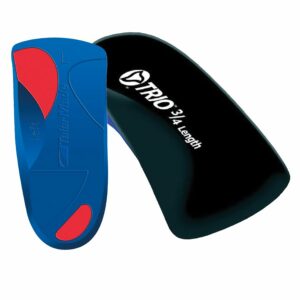 Talar Made TRIO Orthotics (3/4 length)
Talar Made TRIO Orthotics (3/4 length) -
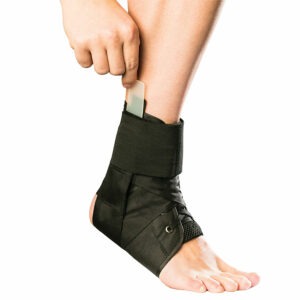 AllCare Ortho Total Ankle Brace (AOA19)
AllCare Ortho Total Ankle Brace (AOA19) -
 Forearm Crutches Adjustable – Standard Grip
Forearm Crutches Adjustable – Standard Grip -
 AllCare Wobble Board (Red – ACWOBRD)
AllCare Wobble Board (Red – ACWOBRD) -
 AllCare Band
AllCare Band -
 Premium Strapping Tape 38mm (Victor)
Premium Strapping Tape 38mm (Victor) -
 AllCare Tubing
AllCare Tubing -
 Fixomull Stretch 5cm x 10m
Fixomull Stretch 5cm x 10m -
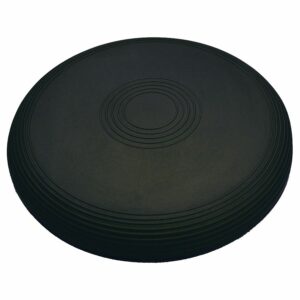 Lournet Stability Dura Disc
Lournet Stability Dura Disc -
 AllCare Ortho Standard Walker (Cam Boot)
AllCare Ortho Standard Walker (Cam Boot) -
 Thermoskin Heat Retaining Ankle Wrap
Thermoskin Heat Retaining Ankle Wrap
To purchase physiotherapy products for a navicular stress fracture click on one of the above links, or visit the PhysioAdvisor Shop.
 Find a Physio for a navicular stress fracture
Find a Physio for a navicular stress fracture
Find a physiotherapist in your local area who can treat a navicular stress fracture.
 More Exercises
More Exercises
- View more Ankle Stretches.
- View Ankle Strengthening Exercises.
- View more Balance Exercises.
- View more Leg Strengthening Exercises.
- View more Leg Stretches.
 More information
More information
- Read about when to use Ice or Heat
- Read about How to use Crutches correctly.
- View detailed information on initial injury management and the R.I.C.E. Regime
- Ensure you have Correct Footwear for running.
- Are you wondering – Do I Need Orthotics?
- View detailed information on a Return to Running Program.
- Read our guide on safely Returning to Sport.
- View our Foot Diagnosis Guide
Become a PhysioAdvisor Member
-
 Individual Membership (12 Months)$59.95 for 1 year
Individual Membership (12 Months)$59.95 for 1 year -
 Individual Membership (3 Months)$39.95 for 3 months
Individual Membership (3 Months)$39.95 for 3 months -
 Individual Membership (Yearly)$49.95 / year
Individual Membership (Yearly)$49.95 / year -
 Individual Membership (Monthly)$15.95 / month
Individual Membership (Monthly)$15.95 / month

Link to this Page
If you would like to link to this article on your website, simply copy the code below and add it to your page:
<a href="https://physioadvisor.com.au/injuries/foot/navicular-stress-fracture”>Navicular Stress Fracture – PhysioAdvisor.com</a><br/>PhysioAdvisor offers detailed physiotherapy information on a navicular stress fracture including: causes, signs and symptoms, diagnosis, treatment, exercises, rehabilitation guide, physiotherapy products and more...
Return to the top of Navicular Stress Fracture.
